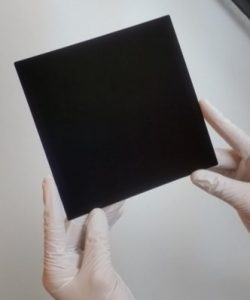New World Record Established for Conversion Efficiency in a Crystalline Silicon Solar Cell
―Conversion Efficiency of 26.63% Achieved in a Practical Cell Size―
August 25, 2017
Kaneka Corporation (Head office: Osaka; President: Mamoru Kadokura) has achieved the world’s highest*1 conversion efficiency of 26.63% in a practical size (180 cm2) crystalline silicon solar cell, breaking the record we achieved last year (26.33%)*2 by 0.3%. This result has been achieved*3 with a heterojunction back-contact crystalline silicon solar cell*4 which we have been developing and it was published in Nature Energy*5 Furthermore, this result was published in June as the world’s highest value in “Solar cell efficiency tables (Version 50)*6” which lists the records of conversion efficiencies for various kinds of solar cells, together with the world’s highest conversion efficiency of 24.37%*7 in a crystalline silicon solar cell module which we achieved last year. These results have also been published at Natureasia.com.
We will continue to develop solar cell technology for improving the conversion efficiency, reducing the manufacturing costs and improving the reliability. We will also advance development for practical use of high-efficiency solar cell products that utilize this result focusing on providing effective solutions to net zero energy housing (ZEH) and net zero energy building (ZEB).

Heterojunction back-contact crystalline silicon solar cell
- As of August 21, 2017, for non-concentration type crystalline silicon solar cells. [Search by Kaneka Corporation]
- Published on September 14, 2016 jointly with New Energy and Industrial Technology Development Organization (hereinafter referred to as “NEDO”).
- Achieved through collaborative research with NEDO.
- A crystalline silicon solar cell which incorporates heterojunction technology and back-contact technology. Heterojunction technology is technology which binds together plural kinds of semiconductors having different material properties such as combining crystalline silicon with amorphous silicon to reduce defects which lower conversion efficiency or combining materials which convert the light energy of different wavelength ranges into electricity to obtain a higher conversion efficiency. Back-contact technology, which forms electrodes only on the back face of solar cells, can make the light receiving area of the top face larger by gathering up all the electrodes on the back face and as a result enhance conversion efficiency.
- “Silicon heterojunction solar cell with interdigitated back contacts for a photoconversion efficiency over 26%”, Nature Energy 2, 17032, 2017.
- M.A. Green, Y. Hishikawa, W. Warta, et al, “Solar cell efficiency tables (version 50)”, Progress in Photovoltaics 25, 668, 2017.
- Published on October 27, 2016 jointly with NEDO.
